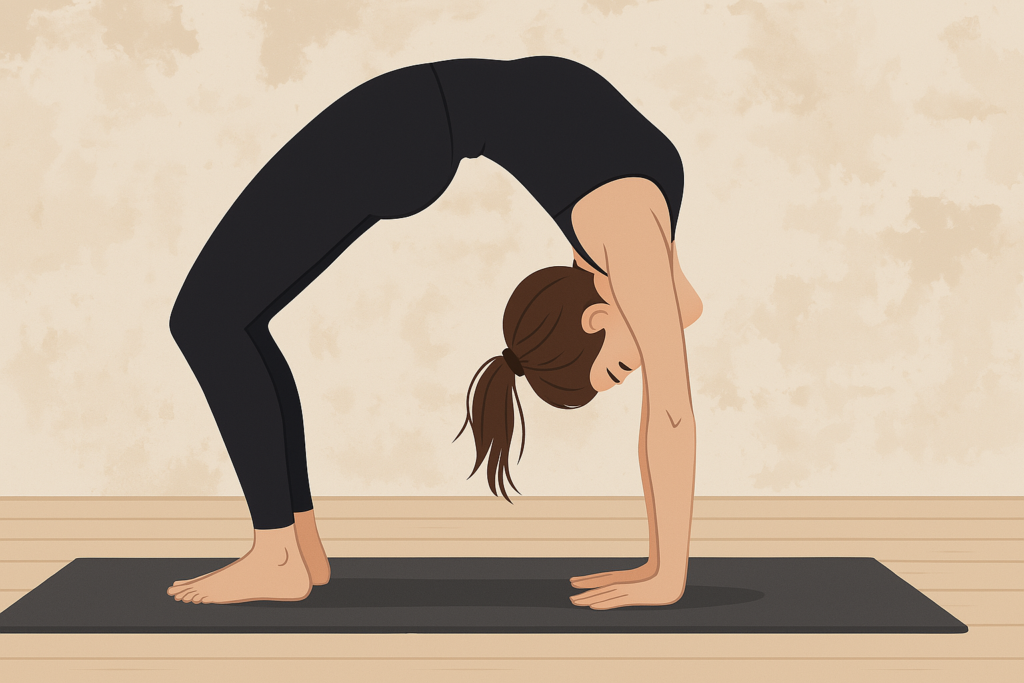Sanskrit Name: चक्रासन
English Name: Wheel Pose
Description:
Chakrasana, commonly referred to as Wheel Pose, is an advanced backbend in yoga that enhances chest opening, spinal flexibility, and strengthens both the arms and legs. In Sanskrit, “Chakra” (चक्र) translates to wheel or circle, while “Asana” (आसन) means pose or posture. Thus, Chakrasana means Wheel Pose, which reflects the circular shape your body forms during the practice. This name emphasizes the energetic and physical opening of the chest, hips, and heart that the pose encourages. As a fundamental pose in Hatha Yoga, Chakrasana is recognized for boosting strength and flexibility. The wheel symbolizes energy, movement, and transformation. Practicing Chakrasana is believed to activate and balance the body’s energy, allowing prana (life force) to flow freely through the chakras, especially the heart and solar plexus chakras. Engaging in this pose can foster emotional release, renewal, and a sense of openness.
Benefits:
- Spinal Flexibility: It enhances the flexibility of the spine, improving posture and alleviating back pain.
- Strengthens Muscles: This asana strengthens the arms, legs, and core muscles, contributing to overall body strength.
- Stimulates Organs: It stimulates the digestive organs, promoting better digestion and alleviating issues like constipation.
- Improves Lung Capacity: The pose opens up the chest and lungs, enhancing respiratory function and increasing lung capacity.
- Boosts Mood: Practicing Chakrasana can elevate mood and reduce stress and anxiety by promoting the release of endorphins.
- Balances Energy: It helps in balancing the energy flow in the body, aligning with the heart chakra, which can foster emotional stability.
Medical Conditions(Relief):
- Back Pain: This asana helps stretch and strengthen the spine, alleviating discomfort in the back.
- Respiratory Issues: By opening the chest, it enhances lung capacity and improves breathing.
- Digestive Problems: The pose stimulates abdominal organs, promoting better digestion and alleviating issues like constipation.
- Fatigue and Stress: It energizes the body and mind, helping to reduce feelings of fatigue and stress.
- Anxiety and Depression: Practicing Chakrasana can uplift mood and relieve symptoms of anxiety and depression by boosting overall energy and confidence.
Medical Conditions(Avoid):
- Back Injuries: Individuals with acute or chronic back injuries may exacerbate their condition by attempting this pose.
- Carpal Tunnel Syndrome: This pose places significant pressure on the wrists, which can worsen symptoms for those with carpal tunnel syndrome.
- Shoulder Injuries: Those with shoulder injuries or instability should avoid this asana to prevent further damage.
- Pregnancy: Pregnant women should avoid this pose, especially in the later trimesters, due to the strain on the abdomen and lower back.
- High Blood Pressure: This pose can increase blood pressure, so individuals with hypertension should refrain from practicing it.
- Glaucoma: The inversion aspect of Chakrasana can increase pressure in the eyes, making it unsuitable for those with glaucoma.
- Hernia: Individuals with a hernia should avoid this pose as it may aggravate their condition.

